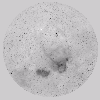 For a GIF image click here
For a GIF image click hereMartin Observatory, Institute for Particle Physics and Astrophysics,
Department of Physics, Virginia Tech
From HI observations, Normandeau,Taylor and Dewdney have identified a possible galactic chimney emanating from W4. We observed a 13 degree diameter field centered on the chimney in the Balmer-alpha line using a CCD camera sensitive to faint emission. Our observations reveal a pair of wisps diverging from the W4 region, and approximately coincident with the boundaries of the chimney as indicated by the HI void. These wisps can be traced to great distance. They appear to close six degrees (approximately 200 pc) from W4 and seven degrees above the galactic plane. These observations lend support to the chimney hypothesis and suggest that we may be seeing the ionized inner surface of a large shell formed by stellar outflows from the W4 region. This research was supported by NSF grant AST-9319670 and a grant from the Horton Foundation to Virginia Tech.
On the night of 17 October 1995 we obtained a 13 degree diameter H-alpha image of the star forming regions W3,W4, and W5 using the Spectral Line Imaging Camera (SLIC). Our image (see link below) was obtained by averaging 12 ten minute exposures and removing the highest pixel value at each pixel location to remove the effects of cosmic rays. We therefor have a 110-minute integration image on the regions mentioned above.
The most interesting feature is the continuation of the chimney discovered by Magdalen Normandeau and Russ Taylor (University of Calgary) and Peter Dewdney (Dominion Radio Astrophysical Observatory) during the pilot project of their Galactic Plane Survey. Their 21 cm HI image shows a conical cavity with its apex near W4, extending away from the galactic plane. In their radio continuum image there is a filament on the left side of the W4 region which stretches out of the galactic plane. They suggest that this filament represents a wall of material that is ionized by stellar radiation in the chimney. They cite other evidence to suggest that this region might be a galactic chimney (e.g. a streaming effect associated with a compact CO cloud inside the chimney as seen in their atomic hydrogen image.
We obtained a larger, sensitive image of this region in H-alpha and discovered that the filaments emanating from W4 appear to close some six degrees (about 200 pc) from the star forming region and seven degrees above the galactic plane. The most straight forward interpretation is that the outflow from energetic stellar processes has created this apparent shell which has yet to open into a fully developed chimney. The filaments seen by us in H-alpha and by Normandeau et al. in the radio continuum near W4 appear to represent the inner wall of the cavity ionized by stellar radiation from early type stars within W4.
 For a GIF image click here
For a GIF image click here